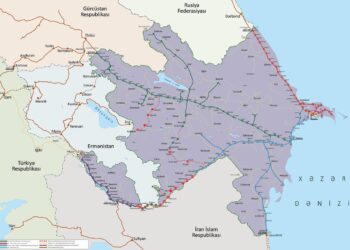Azerbaijan has officially confirmed the receipt of five JF-17 Block III fighter jets delivered from Pakistan, marking a significant enhancement to its air combat capabilities. The acquisition, reported by Army Recognition, underscores the strengthening defense ties between the two countries and highlights Azerbaijan’s efforts to modernize its military fleet amid regional security challenges. The advanced multirole fighters are expected to bolster Azerbaijan’s strategic deterrence and operational readiness in a rapidly evolving security environment.
Azerbaijan Strengthens Air Power with Arrival of Advanced JF-17 Block III Fighters
Azerbaijan has officially received five JF-17 Block III fighter jets, marking a significant boost to its air defense capabilities. These multirole combat aircraft, developed jointly by Pakistan and China, are equipped with state-of-the-art avionics, advanced radar systems, and enhanced weaponry, providing a considerable edge in both air-to-air and air-to-ground missions. The integration of these jets into the Azerbaijani Air Force fleet reflects a deepening military cooperation between Baku and Islamabad, aimed at modernizing regional defense infrastructures.
The JF-17 Block III variant features several improvements over its predecessors, including:
- An Active Electronically Scanned Array (AESA) radar for superior target detection and tracking
- Improved cockpit ergonomics with a modernized display and control system
- Enhanced electronic warfare suite for increased survivability
- Capability to deploy beyond visual range missiles adding tactical versatility
| Specification | JF-17 Block III |
|---|---|
| Top Speed | 1,960 km/h |
| Combat Radius | 1,352 km |
| Armament Capacity | 3,700 kg |
| Crew | 1 Pilot |
Technical Capabilities of JF-17 Block III Elevate Azerbaijan’s Tactical Edge
The integration of the JF-17 Block III fighters into Azerbaijan’s air force marks a significant leap forward in its combat capabilities, featuring state-of-the-art avionics and superior multi-role functionality. Equipped with an advanced active electronically scanned array (AESA) radar, the aircraft enhances target detection and tracking range, allowing pilots to engage multiple threats simultaneously with pinpoint accuracy. The Block III’s improved cockpit displays and digital fly-by-wire system further elevate pilot situational awareness and maneuverability, essential for dynamic combat environments over the disputed regions. Additionally, the enhanced electronic warfare suite bolsters survivability against modern air defense systems, contributing to a robust tactical edge.
The arsenal carried aboard the Block III supports a diverse array of mission profiles, ranging from air superiority to precision ground strikes. Key features include:
- Beyond Visual Range (BVR) missiles: Capable of neutralizing enemy aircraft before visual contact.
- Precision-guided munitions: For surgical strikes minimizing collateral damage.
- Enhanced data link systems: Enabling seamless communication with ground assets and other allied platforms in real-time.
| Capability | Specification | |||||||||||
|---|---|---|---|---|---|---|---|---|---|---|---|---|
| Max Speed | Mach 1.6+ | |||||||||||
| Service Ceiling | 16,000 meters | |||||||||||
| Combat Radius | 1,350 km | |||||||||||
| Overview of JF-17 Block III Fighter Capabilities Avionics and Combat Systems:
Weaponry:
Specifications: | Capability | Specification | If you provide the missing details from the rest of the table or any other elements you want included, I can complete or expand on this summary accordingly. Strategic Recommendations for Integrating New Fighter Jets into Azerbaijan’s Defense FrameworkTo maximize the operational effectiveness of the newly acquired JF-17 Block III fighter jets, Azerbaijan’s defense framework should prioritize a phased integration process. This approach ensures seamless assimilation within the existing air force infrastructure while enabling comprehensive pilot training tailored to the advanced avionics and combat systems featured in the Block III model. Key focus areas include:
Additionally, establishing a robust support ecosystem is critical. This involves setting up technical partnerships for spare parts and software updates, alongside investing in indigenous R&D to customize the platforms according to Azerbaijan’s strategic priorities. The following table outlines a recommended integration timeline emphasizing milestones crucial for operational readiness:
Future OutlookThe delivery of five JF-17 Block III fighter jets from Pakistan marks a significant enhancement of Azerbaijan’s aerial capabilities, reflecting growing defense cooperation between the two nations. As Azerbaijan continues to modernize its military arsenal, this acquisition is expected to bolster its strategic posture in the region. Further developments and operational integration of the new jets will be closely watched by defense analysts and regional observers alike. ADVERTISEMENT |
















